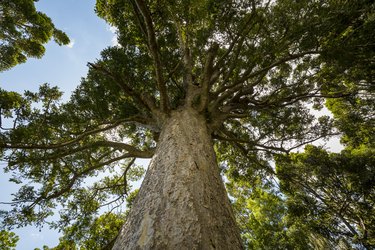
The kauri tree (Agathis australis, USDA plant hardiness zone 9) is a coniferous tree that is most common in its native New Zealand. It is often used in warmer areas of the United States as a landscaping tree. When fully mature, the kauri provides excellent shade and offers a unique appearance that many homeowners seek for their yards. It's important to know what to expect from your tree as well as how to care for it properly.
Facts About Kauri Trees
Video of the Day
The kauri is described as an evergreen tree, but it looks rather different from most coniferous evergreens with which you may be familiar. Kauri trees can grow between 100 to 160 feet in height. They tend to have large trunks, which can grow to be anywhere from 3 to 23 feet in diameter.
Video of the Day
Part of the appeal of kauri trees in landscaping lies in the height of their branches from the ground. Oftentimes, large kauris have branches that are as high as 50 feet off the ground. This allows people to walk freely on the ground beneath the kauri, and it keeps yards looking open and spacious. It also cuts down on upkeep, though branches may interfere with power lines and require professional trimming from time to time.
The bark of a kauri tree is a grayish-blue color, and it is very thick. When the tree drops its bark, it does so in large pieces. The tree generates large amounts of amber. Its leaves are distinctive and are leatherlike and short when young. Older trees might have oblong leaves that are a bit longer.
Growing a Kauri Tree
When deciding where to plant a kauri tree, you should consider the light available in your yard. These trees grow best with plenty of sunlight but also a bit of shade, so don't place them where they'll be overshadowed by large trees or be kept in the shade of your home at all times.
Kauri trees require soil that is well-draining, and they require regular watering. Some experts say that the plant can survive in soils that are loamy, clay or a bit sandy. Note that the plants should not be overwatered. If you intend to plant more than one kauri, space it at least 15 feet but ideally 20 feet away from the next. This will allow it plenty of room to grow properly.
More Kauri Tree Information
Believe it or not, the kauri tree can live for over 2,000 years. They once covered 1.2 million hectares in New Zealand, but these forests have shrunk over time for a variety of reasons. The Maori people often used the wood of kauri trees to make boats and houses, and they also used it for carving. The gum of the tree could be utilized to start fires. Over time, the gum of the kauri tree began to be used to make chewing gum, varnishes and other products that were resinlike in nature.
In New Zealand today, there are calls to protect and preserve the remaining kauri forests. Many of the forests that remain contain adolescent kauri trees. Some conservation experts suggest creating a national park of some kind surrounding these trees to protect them and raise awareness of their history and importance.